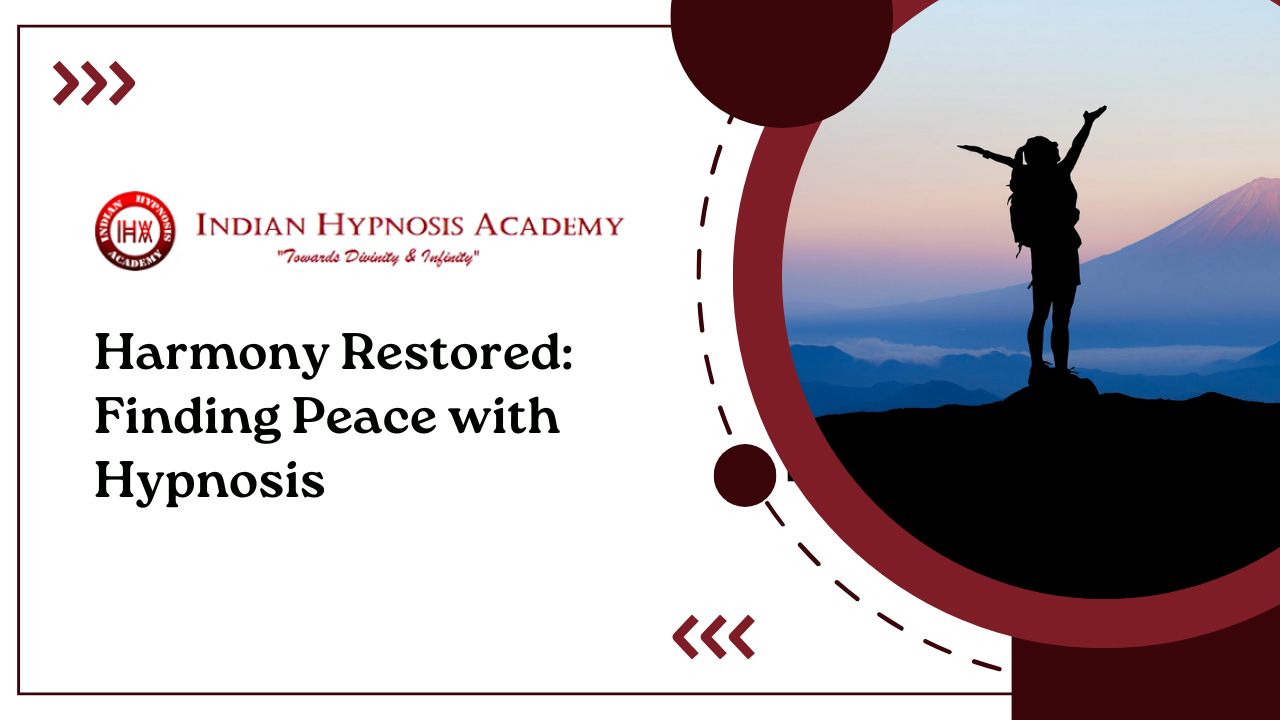Introduction to Hypnosis
Imagine slipping into a state of calm where worries fade, and clarity emerges. Hypnosis, often misunderstood and shrouded in mystery, is like stepping into a sanctuary for your mind. It offers an opportunity to pause the chaos of everyday life and reconnect with your inner self.
Many people are skeptical about hypnosis. They associate it with stage performances or sensationalized depictions in movies. However, this ancient practice has much more to offer than mere entertainment. It holds the potential for profound healing and personal growth.
As we delve deeper into the world of hypnosis, you’ll discover how it can help restore harmony in your life—whether you’re seeking relief from stress, overcoming phobias, or simply striving for emotional balance. Let’s embark on this journey together to uncover the power of hypnosis in finding peace within yourself.
How Hypnosis Works?
Hypnosis operates by tapping into the subconscious mind. This is where your beliefs, memories, and emotions reside. A skilled hypnotherapist guides you into a state of deep relaxation.
During this process, your brain waves shift from active beta to calmer alpha and theta states. In these altered states of consciousness, you’re more open to suggestion.
Your conscious mind takes a back seat while the therapist communicates directly with your subconscious. This allows for transformative change at a deeper level than typical talk therapy might reach.
The experience may feel like daydreaming or intense focus, often leading to heightened awareness rather than sleepiness. You remain in control throughout; it’s not about losing yourself but finding clarity within yourself.
It’s an exploration of your inner landscape—a journey toward understanding and healing that can bring significant shifts in perspective and behavior.
Benefits of Hypnosis
Hypnosis offers a wide array of benefits for those seeking mental and emotional balance. It can be an effective tool for stress reduction, helping individuals enter a state of deep relaxation.
Many people turn to hypnosis to manage anxiety and phobias. By addressing the root causes of fear, it allows individuals to regain control over their thoughts and emotions.
Additionally, hypnosis has been used successfully in pain management. Whether it’s chronic pain or discomfort from medical procedures, many find relief through guided suggestions.
Improving sleep quality is another significant advantage. Hypnosis can help break the cycle of insomnia by promoting restful states before sleep.
Weight loss is often supported through behavioral changes instilled during hypnotherapy sessions. This approach addresses cravings at a subconscious level for lasting results.
These varied benefits make hypnosis a versatile option for anyone looking to enhance their overall well-being.
Common Misconceptions About Hypnosis
Many people have misconceptions about hypnosis that create fear or skepticism. One of the most common beliefs is that it’s a form of mind control. In reality, you remain fully aware and in control throughout the process.
Another myth is that only certain individuals can be hypnotized. The truth is, anyone who is open to suggestion can experience hypnosis, regardless of their personality type.
Some think it’s just a stage trick for entertainment. While there are entertaining performances, clinical hypnosis serves therapeutic purposes such as stress relief and behavior modification.
People often believe they’ll lose consciousness during sessions. However, most report feeling deeply relaxed yet alert—similar to daydreaming.
There’s a notion that hypnosis works instantly. Like any therapy, results vary based on individual needs and commitment to the process.
Finding the Right Hypnotherapist for You
Choosing the right hypnotherapist can feel overwhelming. It’s essential to find someone who resonates with you on a personal level.
Start by researching their qualifications and experience. Look for certifications from recognized institutions, as this indicates a solid foundation in hypnosis practices.
Don’t hesitate to read reviews or testimonials from previous clients. Their experiences can provide valuable insights into what you might expect.
Schedule an initial consultation if possible. This meeting allows you to gauge your comfort level with the therapist and assess their approach.
Ask questions about their techniques and areas of expertise. Understanding how they tailor sessions will help ensure they align with your specific needs.
Trust your instincts during this process. A good rapport is vital for effective therapy, so listen closely to your feelings when making your choice.
The Process of a Hypnosis Session
A hypnosis session typically begins with a comfortable setting. You’ll usually sit or lie down in a quiet room, free from interruptions. The hypnotherapist will guide you to relax your body and mind.
Next comes the induction phase. This involves techniques like deep breathing or visualization to help you enter a calm state of focused attention. During this stage, the therapist may use soothing language to deepen your relaxation.
Once you’re in this relaxed state, suggestions are offered gently. These can address specific issues such as stress reduction or habit change. Your subconscious is more open during this time, making it easier for positive changes to take root.
After the suggestion phase, you’ll gradually be brought back to full awareness. Most sessions end with discussions about what you’ve experienced and any insights gained during the process. It’s often enlightening and empowering, leaving you feeling refreshed and hopeful.
Real Life Success Stories with Hypnosis
Many individuals have experienced profound transformations through hypnosis. One inspiring story comes from Sarah, who struggled with anxiety for years. After just a few sessions, she found herself more relaxed and capable of facing daily challenges without overwhelming fear.
Another remarkable case is that of John, a long-time smoker. With the help of hypnosis, he was able to quit smoking after multiple failed attempts. His cravings diminished significantly, allowing him to embrace a healthier lifestyle.
Then there’s Lisa, who used hypnosis to ease chronic pain following an injury. Through guided imagery and relaxation techniques during her sessions, she discovered relief where traditional medicine had fallen short.
These stories illustrate how powerful the mind can be when harnessed effectively through hypnosis. Each individual’s journey highlights not just success but also hope for those seeking change in their lives.
Combining Hypnosis with Other Therapies
Hypnosis can seamlessly integrate with various therapeutic approaches, enhancing their effectiveness. For instance, combining hypnosis with cognitive-behavioral therapy (CBT) allows individuals to address negative thought patterns while also accessing the subconscious mind.
This dual approach helps solidify positive changes and reinforce new behaviors. Clients often find that the insights gained during a hypnotic state amplify their understanding of personal challenges.
Another powerful combination is pairing hypnosis with mindfulness practices. This synergy fosters deeper relaxation and encourages greater awareness of one’s thoughts and feelings. As clients learn to navigate their emotions, they cultivate resilience against stressors in daily life.
Moreover, using hypnosis alongside traditional medical treatments may assist in managing pain or anxiety related to health issues. By addressing both physical sensations and psychological responses, patients can experience improved outcomes.
Exploring these combinations opens doors for holistic healing that respects individual needs while promoting overall well-being.
Self-Hypnosis Techniques for Daily Use
Self-hypnosis can be a powerful tool for daily peace. It allows you to tap into your subconscious mind and promote relaxation whenever needed.
Begin with deep breathing. Inhale slowly through your nose, hold it briefly, then exhale softly. This simple act calms the body and prepares you for deeper work.
Next, create a mental image that resonates with you—a tranquil beach or a peaceful forest. Visualize every detail vividly; this will help transport your mind to a serene place.
Use affirmations as well. Phrases like “I am calm” or “I embrace positivity” can reinforce positive thoughts during your self-hypnosis practice.
Setting aside just ten minutes each day creates consistency in using these techniques. With time, you’ll find it easier to enter that state of relaxation whenever life feels overwhelming.
Conclusion: Embracing Harmony Through Hypnosis
Embracing harmony through hypnosis offers a transformative journey towards inner peace. This powerful tool taps into the subconscious mind, allowing individuals to access deeper layers of understanding and healing. With proper guidance from a qualified hypnotherapist, many have found relief from anxiety, stress, and various life challenges.
The integration of hypnosis with other therapeutic approaches can amplify results, creating a holistic path to wellness. Moreover, self-hypnosis techniques empower you to take an active role in your mental health every day.
As more people discover the benefits of this practice, it becomes evident that achieving balance is not just possible but attainable for anyone willing to explore their mind’s depths. Letting go of misconceptions about hypnosis opens doors to new possibilities in personal growth.
By fostering mindfulness and embracing the resilience within ourselves through these techniques, we can truly restore harmony in our lives. Whether seeking professional help or practicing self-hypnosis at home, each step taken toward relaxation contributes significantly to overall well-being. Invite tranquility into your life by exploring what hypnosis has to offer; it’s time for you to experience its remarkable potential firsthand.




